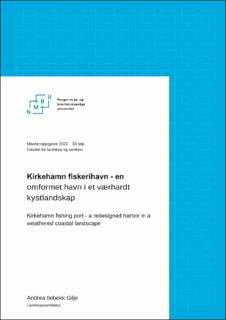| dc.contributor.advisor | Husaas, Ellen Merete | |
| dc.contributor.author | Gilje, Andrea Ilebekk | |
| dc.coverage.spatial | Norway, Agder, Flekkefjord, Hidra, Kirkehamn | en_US |
| dc.date.accessioned | 2023-01-04T12:05:49Z | |
| dc.date.available | 2023-01-04T12:05:49Z | |
| dc.date.issued | 2022 | |
| dc.identifier.uri | https://hdl.handle.net/11250/3040921 | |
| dc.description.abstract | Masteroppgaven utforsker hvordan landskapsarkitektur kan utforme kystlandskap til å bedre rustes for fremtidens økende ekstremvær og havnivå, med utgangspunkt i Kirkehamn fiskerihavn som prosjektområde. Kombinasjonen av havnas endrede bruk samt dens vær- og havutsatte plassering gjør den ideell som oppgaveområde for oppgavens tema.
Gjennom prosesser og grep i dette kyst-rommet, utarbeides det i oppgaven et forslag til hvordan man kan transformere en næringshavn til et allment uterom for kombinert bruk. Kunnskapsgrunnlaget for oppgaven ble innhentet gjennom befaring, tematisk vandring, stedsanalyser, spørreundersøkelse av Hidras lokalbefolkning, og tilegnet aktuell kunnskap om stedsdefinerende kvaliteter.
Oppgaven utforsker hvordan Kirkehamn fiskerihavn kan omformes til et trygt og bærekraftig uteareal som kan benyttes i varierte værforhold, som tåler stedets fremtidige klima, og som tilrettelegger for kombinert bruk av havna. I prosessen har jeg hatt fokus på grep som kan bidra med å restaurere det biologiske mangfoldet på stedet, redusere grå flater, samt bedre opplevelseskvaliteten og fremheve kystidentiteten. | en_US |
| dc.description.abstract | This master thesis explores landscape architecture's role in design for coastal landscapes, in becoming better equipped for the increase in extreme weather and rise in sea levels predicted in the future. The thesis’ project area is Hidra Kirkehamn fishing harbor in Flekkefjord municipality. This harbor's change in use and its weather- and sea prone location makes it ideal to explore the thesis’ theme.
Through analysis and measures of the given coastal space, the thesis develops a proposal of how to transform a former industrial harbor into a public area for combined use. The basis of knowledge for this thesis was obtained through field work, a historic guide, site analyzes and registrations, a local survey, and research on the defining qualities of the thesis' project area.
The thesis explores how landscape architecture can transform a fishing harbor into a safe and sustainable outdoor area, appropriate in varied weather conditions, withstanding to the challenges of future climate, and that facilitates for different user areas of the harbor. In the design process I have focused on measures that can help restore the harbor’s biodiversity, reduce the harbor’s gray surface, and highlight the harbors surrounding esthetics and coastal identity. | en_US |
| dc.language.iso | nob | en_US |
| dc.publisher | Norwegian University of Life Sciences, Ås | en_US |
| dc.rights | Attribution-NonCommercial-NoDerivatives 4.0 Internasjonal | * |
| dc.rights.uri | http://creativecommons.org/licenses/by-nc-nd/4.0/deed.no | * |
| dc.subject | Kystlandskap | en_US |
| dc.subject | Biologisk mangfold | en_US |
| dc.subject | Landskapsarkitektur | en_US |
| dc.subject | Kystøkologi | en_US |
| dc.subject | Coastal landscape | en_US |
| dc.subject | Coastal ecology | en_US |
| dc.subject | Biodiversity | en_US |
| dc.subject | Landscape architecture | en_US |
| dc.title | Kirkehamn fiskerihavn : en omformet havn i et værhardt kystlandskap | en_US |
| dc.title.alternative | Kirkehamn fishing port : a redesigned harbor in a weathered coastal landscape | en_US |
| dc.type | Master thesis | en_US |
| dc.description.localcode | M-LA | en_US |

